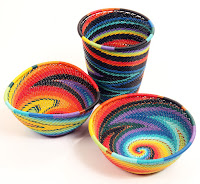 |
| Wall of Zimbabwe baskets by ChicvilleUSA.com |
Baskets look amazing when they are mounted to a wall, like this display created by ChicvilleUSA.com. But how do you hang a basket on a wall?
 |
| Holding baskets up to the light help you find holes through which to feed the line. |
1) most baskets are light enough to hang with fishing line (I use “Multi-Purpose Line” that is supposed to be able to handle up to 15 lbs.) and a small nail;
2) hold your basket up to a light to see where fishing line can be fed through;
3) create the fishing line loop near the center of the basket so that it will lay flat on the wall.
Both
ChicvilleUSA and HGTV mention using nails driven through the center of baskets
to hang them. This would be faster and easier, but it would also damage most of
the baskets and be noticeable from close-up.
Each Type of Basket Will be Different
Winnowing
baskets, like Binga and Gokwe baskets from Zimbabwe, are of the most
popular kinds of baskets to hang. They are relatively flat, very lightweight, and have a loose weave, so even the largest baskets are a breeze to hang.
Shallow bowls from Botswana have a smooth surface because they are very tightly stitched.
To hang a Botswana basket, feed the fishing line through several of the
stitches that cover the coils, then tie the fishing line into a loop.
Chivi baskets from Zimbabwe feature starburst patterns that look amazing on a wall –
but they also have very thick, heavy coils. Distribute the weight of the basket by feeding
the fishing line through several of the twine stitches before creating a loop.
Sisal bowls from Rwanda come with a loop on the back, so they come to you ready to
hang… ta-da!
Rwenzori bowls from southern Uganda are colorful, geometric, and smooth. They are lightweight, but have a tight weave, so to create a loop you will need to feed fishing line work from the front of the basket. Using needle-nosed tweezers, carefully push the line between the coils to the back of the basket (see photos below).
 |
| Bukedo & Raffia baskets often come with loops woven into the basket. To hang my heavy 23-inch basket, I used a strong hook and made sure it was in a wall stud. |
My wall of baskets (see photo below) is a work in progress; there is room to grow. I would love to add some Mini Botswana bowls. They are about 6.75" wide, and the warm colors and linear designs would be different than the patterns I have so far. But the texture of the Botswana baskets is what I love. They are intricately woven, so the surface is smooth, but the materials are earthier and less "polished" than the Rwenzori bowls.
 |
| For these Rwenzori bowls, I fed the fishing line from the FRONT of the basket, then tied a knot to make a loop. The line is nearly invisible from the front of the basket. |
 |
| For Binga baskets (left), Zulu Wire baskets (center), and Gokwe baskets (right), you can feed the line from the back. |
 |
| Here is my finished wall! From the top left: 11-inch Masterweave Binga, 23-inch Banded Weave Bowl from Uganda, 7-inch Rwenzori, 12-inch Munyumbwe bowl, another 7-inch Rwenzori, and a 12-inch Gokwe. All baskets are from Baskets of Africa. |
 |
| The Zulu Wire bowl matches the glaze on my ceramic lamp, and is colorful and intricate enough to be on a wall by itself. |



















